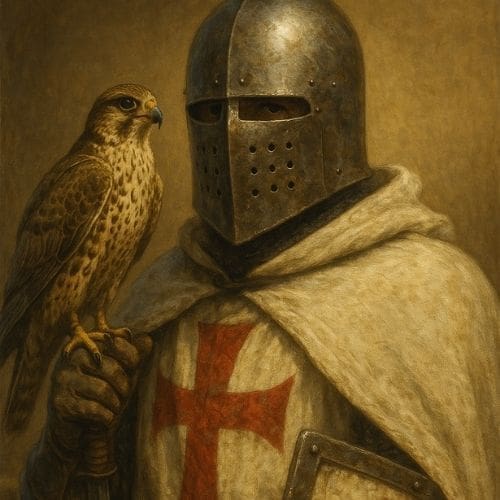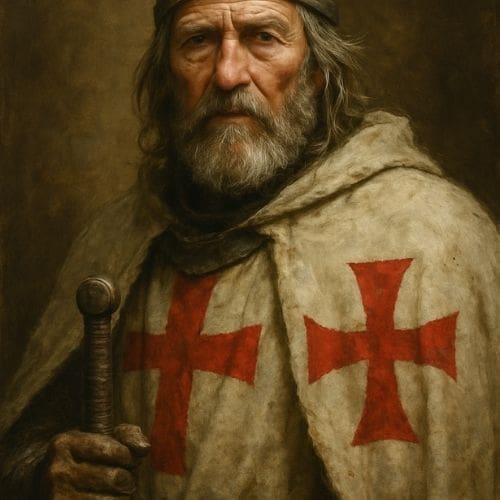Few tales in medieval history end with as much mystery, betrayal, and enduring superstition as The Fall of the Templars, the dramatic downfall of the Knights Templar. Once the most powerful military order in Christendom, these warrior-monks were revered, feared — and ultimately destroyed in a storm of accusations, torture, and royal ambition.
Their story not only shook the foundations of medieval Europe but gave rise to one of the world’s most persistent myths: the sinister legend of Friday the 13th.
From Holy Warriors to Political Pawns

The Knights Templar were born of noble cause. Founded in the aftermath of the First Crusade around 1119, their original purpose was to protect Christian pilgrims journeying to the Holy Land. Recognised and blessed by the Pope, they took monastic vows of poverty, chastity, and obedience — but unlike traditional monks, they also bore swords.
As the Crusades raged on, the Templars grew in stature. Over the 12th and 13th centuries, they amassed immense wealth, land, and influence across Europe and the Levant. In England and Wales, they built fortresses such as Temple Church in London and Penrhos Templar Preceptory in Anglesey, becoming landlords, bankers, and military elites. Their distinctive white mantles emblazoned with a red cross came to symbolise divine power and disciplined force.
Yet, the very success that made them indispensable also made them vulnerable. Their wealth inspired envy. Their secrecy invited suspicion. And their loyalty to the Pope, rather than kings, sparked political resentment.
King Philip IV: Debt, Power and Paranoia
By the early 14th century, the Crusader dream had crumbled. The Templars, once defenders of Jerusalem, now occupied lavish preceptories in Europe with no holy wars left to fight. At the same time, monarchs like Philip IV of France found themselves drowning in debt — especially to the Templars, who had financed many of his campaigns.
Philip saw an opportunity. If he could destroy the Order, he could erase his debts and claim their riches. But he needed more than greed — he needed justification.
In 1307, Philip acted. On Friday, 13 October 1307, dozens of Templars in France were arrested by royal decree, including Grand Master Jacques de Molay. They were charged with heresy, idolatry, sodomy, and blasphemy — shocking allegations meant to stain both their faith and their reputation.
Torture and Forced Confessions
The methods of medieval justice were brutal. Under torture, many Templars confessed to outrageous claims: spitting on the cross, worshipping a bearded idol called Baphomet, and engaging in secret initiation rites. Some later recanted, others refused — and paid the price.
Inquisitors were relentless. Men were racked, beaten, burned, and starved until they confessed. The confessions gave Philip the veneer of legitimacy he craved. Yet historians now widely agree the charges were fabricated — a cynical ploy to crush a rival power.
In England, King Edward II initially resisted arresting the Templars, demanding proof of their wrongdoing. But under pressure from Pope Clement V, he relented. English Templars were imprisoned, and their estates seized. In 1312, under intense political coercion, the Pope officially dissolved the Order.

The Execution of Jacques de Molay
The end came on 18 March 1314, seven years after the first arrests. Jacques de Molay and fellow leader Geoffroi de Charney were led to an island in the Seine River in Paris. Bound and gagged, they were burned alive as heretics.
Yet de Molay’s death became legend. According to chroniclers, as the flames licked around him, he cursed both Pope Clement and King Philip, summoning them to join him before God within a year. Astonishingly, both men died within months — one of natural causes, the other in a hunting accident.
Thus was born a myth of divine retribution — and the haunting sense that the Templars were victims of a grave injustice.
The Friday the 13th Curse
Why do we still fear Friday the 13th? While the superstition has ancient roots, many trace its enduring association with misfortune to the Templars’ arrest on that ominous October morning.
The mass arrest of these warrior-monks, followed by years of torture, public disgrace, and execution, created a potent symbol of betrayal and dread. In later centuries, popular culture – from historical thrillers to conspiracy theories – breathed new life into the connection. Dan Brown’s The Da Vinci Code and various documentaries have helped embed the myth in modern minds.
Whether the date was unlucky before or not, it became inextricably linked with treachery and loss from that moment forward.
Legacy and Mystery: What Happened to the Templar Treasure?
Even today, the fate of the Templars continues to spark speculation. What happened to their immense treasure? Did some escape with secret knowledge? Were survivors absorbed into other orders, like the Knights Hospitaller, or did they go underground?
In Britain, some believe Templar sites such as Temple Bruer in Lincolnshire or Royston Cave in Hertfordshire hold hidden clues — mysterious carvings, underground chambers, and symbols tied to esoteric beliefs. While many of these are likely post-Templar creations, they have nonetheless fed into the enduring mythos.
The Templar legacy has inspired everything from Freemasonry to modern secret societies. In historical terms, they were a disciplined, pious, and formidable force. But in folklore, they became something more: an enigma cloaked in secrecy, martyrdom, and half-truths.
A Brotherhood Betrayed
The fall of the Templars was not just a historical footnote — it was a calculated political takedown of an organisation that had grown too powerful for its time. Their tragic end reflects the dangers of unchecked ambition and the fragility of power when politics and religion collide.
For lovers of medieval history, the Templars remain endlessly fascinating. Their story — of holy duty, brutal downfall, and mysterious afterlife — is one of the most compelling chapters in the saga of the Crusades.
And next time Friday the 13th rolls around? Spare a thought for the knights who once vowed poverty and obedience, only to be betrayed by the very world they swore to protect.
Templar Knights
Our Templar Knight collection invites you to honour the legacy of history’s most legendary warriors—bold defenders of faith and guardians of medieval legends.
From striking wall plaques and intricate emblems to clothes and accessories emblazoned with the iconic red cross, each item pays homage to the powerful symbolism of the Knights Templar. Whether you admire their mystery or their might, these pieces help you feel closer to their enduring story.





